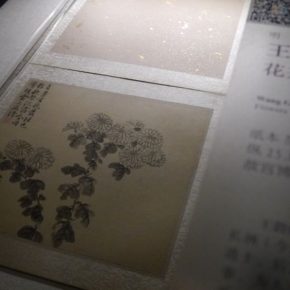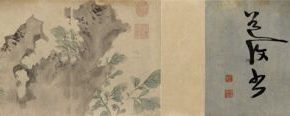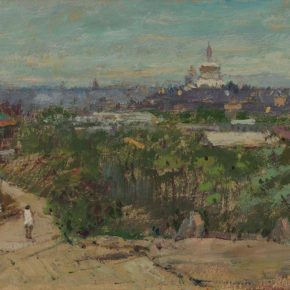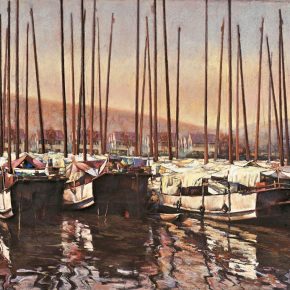
On November 30, 2017, on celebration of the grand victory of the 19th CPC National Congress, “Looking Back 600 Years – Special Painting Exhibition from Four Great Artists of the Ming Dynasty to the Contemporary Wu School”, which is hosted by the National Art Museum of China, the Publicity Department of the CPC Jiangsu Provincial Committee, the Federation of Literary and Art Circles of Jiangsu Province, and Suzhou Municipal People’s Government, with a grand opening at the National Art Museum of China.
The exhibition is divided into three parts, to display a total of 164 paintings containing Chinese paintings, oil paintings, prints and watercolors. Hall 1 mainly displays “Ancient Works” – the classic works of representatives of literati painting, including works of the Four Great Artists of the Ming Dynasty and the Wu School, Dong Qichang and Wang Shimin, Wang Jian, Wang Hui and Wang Yuanqi of the early Qing Dynasty; hall 2 displays a total of 18 modern works, mainly showing the pioneering representatives of Suzhou painters in the transformation of modern painting, such as Wu Hufan and Yan Wenliang’s selected works; hall 3 mainly presents a total of 75 contemporary works, including 35 original pieces selected by the previous national art exhibitions, in which some won prizes, as well as 40 pieces selected after experts reviewed them all.
Looking Back to the Ancient Masterpieces????????The artistic creation of Suzhou has occupied a very important position in the history of Chinese art. The Wu School represented by the Four Great Artists of the Ming Dynasty including Shen Zhou, Tang Yin, Wen Zhengming and Qiu Ying, was one of the genres widely and profoundly influencing Chinese art history.
Since the late Ming dynasty, “Wu School” has continued. Connected with the “Wu School” of the Ming Dynasty, Dong Qichang established the “Songjiang School” with a new style of literati painting. Later, it appeared the “Four Wangs” including Wang Shimin, Wang Jian, Wang Hui and Wang Yuanqi from Taicang and Changshu, located in the Susong area, who inherited the tradition of literati painting established by Dong Qichang and “Songjiang School”, aimed at copying the ancient pieces, paying attention to the brush and ink, in pursuit of the implication of literati painting. Highly praised by the Qing royal family, “Four Wangs” was regarded as the orthodox school, learned by the royal academy of painting, affecting many painters until the late Qing Dynasty and early Republic of China.
Hall 1 presents the ancient classic pieces from Suzhou paintings and a memorabilia and chronology of Suzhou art in the past 600 years, as well as the masterpieces of well-known modern Suzhou painters which are displayed in a semicircular gallery, completely presenting the history of Suzhou paintings over 600 years. Halls 8 and 9 show the outstanding pieces of the contemporary Wu School.
Inheritance and Integration of Modern PaintingsHall 2 mainly shows the pioneering representatives of Suzhou painters in the transformation of modern painting, such as Wu Hufan and Yan Wenliang’s selected works.
During the period of the late Qing Dynasty and the Republic of China from 1895 to 1949, Suzhou painters freely established 20 associations of painting, and they made outstanding contributions to the formation of the Shanghai School. A large number of Suzhou painters were involved in the Shanghai painting circles, continuing the tradition of the literati gathering of the “Wu School”. On the one hand, traditional art associations of literati such as Yiyuan Painting Gathering, Taowu Painting Society and Suoluo Painting Society, were flourishing; on the other hand, influenced by the Western art, the oil paintings, pastel paintings and watercolor paintings were also gradually developed. Especially in 1922, Yan Wenliang and his fellows followed the trend of the times to found the Suzhou Art School, and then established an art museum, that planned painting competitions and trained a large number of talent in fine arts, together with Xu Beihong, Liu Haisu and Lin Fengmian to open the road of education and creation of Western painting in modern China.
After the founding of New China, Suzhou painting relied on its own conditions to evolve and develop in a new environment, experiencing ups and downs. In 1960, Suzhou Museum of Chinese Painting (and then it was renamed as Suzhou Academy of Chinese Painting) was established, and Zhang Xinjia was the director. Painters used the brush and ink of traditional Chinese painting to reflect the realistic life of new China.
Derivation of the New State of Contemporary Creation??The reform and opening up brought new opportunities and challenges to the Suzhou painting circles. The third part of the exhibition presents a new appearance and a new journey of “Wu Culture” that has crossed 600 years entering a new era. This “new” kernel is derived from a humanistic spirit that is constantly evolving, diverted from the tireless exploration and innovation of artists living in the background of the times. Gu Zhijun’s print of “Infatuation and Legend”, Lu Weixing’s oil painting of “Fishing Village”, and Yu Wufeng’s print of “Twilight” and Yao Gen’s oil painting of “Warm Sunshine” imply the humanistic spirit that implicates the spiritual origins & cultural pulse of the predecessors several hundred years ago, which are beating in the bloodstream of each Suzhou artist. They connect the ancient and present, and own an immense vitality.
Both the planning of the exhibition theme and the presentation of the exhibition are perfect and it is noteworthy that it applies many Suzhou elements in the composition of exhibition space, for example, the Suzhou-garden-style “circle doorway” was regarded as a typical symbol to replace an exhibition partition, forming a poetic context, and in the dark space it also uses high-tech multimedia technology to create a loop playback of poems by Wen Zhengming, Tang Yin and Shen Zhou, so that many audiences stop to enjoy it.
This special exhibition is a gigantic “l(fā)ooking back” – from the superior quality of works of art to the exquisite & orderly exhibition design – the audience enjoys the endless charm of Suzhou, to experience the infinite vitality of the artistic spirit in the art process of the long & wonderful 600 years.
It remained on view till December 10.
Text and photo by Zhang Yizhi, translated by Chen Peihua and edited by Sue/CAFA ART INFO
















































